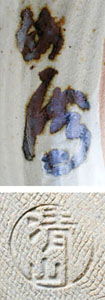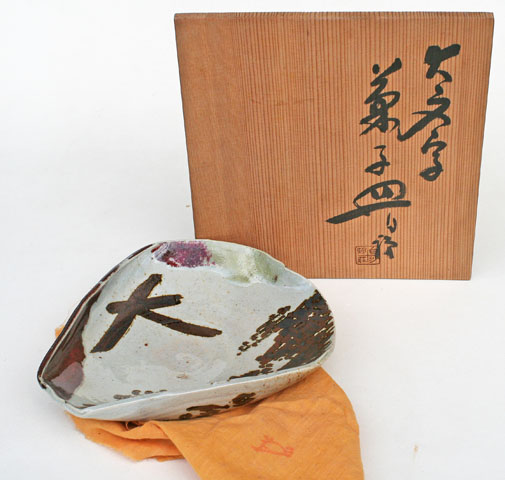Nihonga / Kyôyaki
Kashizara, cake dish - DaimonjiSigned: Kansetsu
Seals: Seizan
Technique: Kyôyaki, Oribe style. Grey gohonde with iron oxide overglaze painting. 19,8 x 23 x 4,4
Box: signed by potter
Condition: fine
Box inscription outside: 大文字菓子皿 白沙「印」白沙邨荘
Daimonji kashizara, cake plate [sign:] Hakusa [seal:] Hakusa sonsô (White sand village villa, house of Kansetsu)
inside: 陶工高橋清山造「印」清山 [signed:] Tôkô (potter) Takahashi Seizan zô [seal:] Seizan
Daimonji refers to the Daimonji Okuribi festival, which starts at 8pm on the 16th of August. Halfway up the mountains which surround the city of Kyoto pine branches are laid out in the shape of the three strokes of the character dai (‘large’). The strokes have a length of 80m, 160m and 120m respectively. Setting the branches on fire marks the beginning the Obon festivities in Kyoto. It is said that the tradition originated when the monk Kobo-Daishi, praying for an end to a plague epidemic, lit up the character for the first time. The bonfire can be seen from every part of the city.
Kansetsu was born in Kobe. His father was a specialist of Chinese studies and a painter in the literati style. His mother was a competent amateur painter and his grandfather had practiced haiku. Kansetsu’s parental home was a meeting point for scholars and artists. Kansetsu first studied painting with his father and subsequently took up the Maruyama-Shijō style with Kataoka Kōkō (dates unknown). In 1903 he became a disciple of Takeuchi Seihō (1864-1942), an immensely influential figure in the Kyoto art world. Seihō had been included in an official delegation that had visited Europe in 1900, a trip that had opened up new artistic horizons for him. Elements of European impressionism can be detected in Kansetsu’s work. Although interested in European art (he travelled to Europe in 1921 and 1927), his main interest was China. He went to China almost every year from 1913 on, all in all more than thirty times. In 1935 he was appointed a member of the Imperial Fine Arts Academy and in 1939 he received the Asahi Culture Prize. His former Kyoto house is now a museum.
Reference:
Kyoto 1957
Kyoto 1977
Conant pp. 293-294
Berry & Morioka ‘99 pp. 224-29
Berry & Morioka ‘08 pp. 261-63
Roberts p. 41
Price: SOLD

